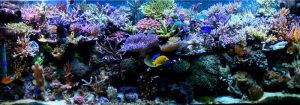 I first would like to thank the Advanced Aquarist’s staff for all their hard work in creating a first class online magazine. What a benefit it is for us “regular folk” in this great hobby to have a place like this, that with just a few mouse clicks we can access so much valuable information. When Wade invited me to have my reef featured I felt honored yet a little hesitant. I was a little worried my aquarium may not be quite up to the standard people might expect but then thought it’s not always about where you are right now but where and what you are striving to be. I hope that through my photos and remarks you will be able to feel the passion I have for this hobby and get a sense of the enjoyment I receive from it. I have always been fascinated with the ocean and diverse life forms we find there. It truly is another world and I love this hobby that allows us to keep a small part of it in our homes. I am grateful to be given this opportunity to share my little piece of the ocean with you.
I first would like to thank the Advanced Aquarist’s staff for all their hard work in creating a first class online magazine. What a benefit it is for us “regular folk” in this great hobby to have a place like this, that with just a few mouse clicks we can access so much valuable information. When Wade invited me to have my reef featured I felt honored yet a little hesitant. I was a little worried my aquarium may not be quite up to the standard people might expect but then thought it’s not always about where you are right now but where and what you are striving to be. I hope that through my photos and remarks you will be able to feel the passion I have for this hobby and get a sense of the enjoyment I receive from it. I have always been fascinated with the ocean and diverse life forms we find there. It truly is another world and I love this hobby that allows us to keep a small part of it in our homes. I am grateful to be given this opportunity to share my little piece of the ocean with you.

History & Tank Profile
I ran freshwater aquariums for years, African cichlids mainly and like many people seldom had less that two tanks going at any given time. When I shut my last one down in the late 1980’s due to a leak I decided at that time that when I eventually got back into the hobby I would switch to salt water. In October 2004 that dream became a realization when I had a tank custom built. I thought I would begin my salt water adventure with a FOWLR and maybe add in a few soft corals to sway back and forth in the flow. I had seen this kind of display at some fish stores and thought they looked pretty cool. Within about four months I found I was actually buying coral as often as fish and my tank slowly started to become a reef. By spring 2005 I was up to about 24 fish, an RBTA, several LPS with a few leathers and mushrooms as well as some Montipora caps and digitata. My original lighting was a 72″ Power Compact fixture which I thought was pretty bright and assumed it was all I would ever need. However, by the summer 2005 I knew I wanted to upgrade to Metal Halides so I could add in some so called “harder to keep” sps coral such as acropora. In July 2005 I upgraded to a 72″ fixture with 3×175 watt & 2x 96 watt PC actinics. In September 2005 I added a sump and Dec 05 upgraded my protein skimmer. I once again figured I was all set. Then in summer 06 I added in an RO/DI unit with an auto top-off going to the sump. I finally switched to R/O because I had a major hair algae outbreak that almost killed my reef. It got so bad that I did a complete tear-down in September 2006 and was rethinking whether or not to even stay in the hobby. I obviously kept going which is a decision I am pleased I made. It turns out that my skimmer was running at about 1/3 capacity for several months which sent my nitrates through the roof. I fixed the skimmer which worked fine for awhile. Right after the skimmer ordeal my main ballast went in my light fixture so I was again at a crossroads. It helped me realize my reef wasn’t where I wanted it to be anyway, so in October 2006 I once again upgraded my lighting. I decided on a 72″ fixture that houses five HQI bulbs, two 150 watt 20 K and three 250 watt 10 K, that would allow me to create a better sunrise and sunset effect with a higher intensity and then added in some moon lights for extra effect. I have since added a T5 fixture to supplement the lighting to help give that little extra pizazz I had been looking for. Now I was closer to the intensity I wanted but the water was getting too hot. I decided after loosing many sps colonies from the heat that I needed a chiller. After installing the chiller I still questioned why it had to keep running so often to keep things cool, I mean my light was hot but not that hot. Anyway, I did some checking and discovered I had a faulty heater that was staying on 24/7 and this had likely been my biggest problem all along. That said the chiller is still a definite necessity and really helps keep the water temperature stable. Around that same time I also changed out the powerheads to tunze‘s with a multi-controller. The difference in the flow and random surge has made a huge difference in keeping my reef happy and growing.

In November 2006 I connected what had been my acrylic 40 gallon cichlid aquarium in-line to use as an ornamental Refugium & Softie tank. The refugium is made up of live rock, soft corals, and macro-algae. This tank has an “old school” sump in the rear where I also keep a “cheato chamber” running on a reverse photo period. I have since added in a 40 gallon frag propagation tank. This has increased my water capacity to approximately 250 gallons. This extra volume along with the increased nutrient exportation has made a huge difference in helping to stabilize the system as well as virtually eliminate nuisance algae growth in the display. Adding more volume to the system meant more water draining to the sump in case of a power failure. Since it will only hold the amount of water that drains from the main display I drilled the sump wall and added an emergency overflow going to a 10 gallon tank. Fortunately, I haven’t needed it so far but I am sure the day will come and it helps give some peace of mind against flooding. As you can see the last two years, have been a “reefer’s roller coaster ride.” It seems whenever my reef starts to do well “Murphy’s law” kicks in and something else happens. The summer of 2007 was to be no different. I discovered our dishwasher located in the kitchen, on the floor directly above where the tank is, had been leaking and dripping straight into the tank for an undetermined amount of time. The drain hose had sprung a leak and who knows what chemicals ended up in the tank between the soapy dish water and the basement ceiling tiles, etc. Needless to say I took immediate action. I changed and added extra carbon and did seven water changes in eight days of 15% each and managed to save the majority of livestock but the SPS took a big hit. Most of it lived although I did I loose several nice pieces. Unfortunately what did live either bleached or browned out, but for the most part over the last six months it has bounced back quite nicely. There are still a few pieces I am patiently waiting on to color back up but my hopes are high. Bad things seem to happen in waves, so of course while the dishwasher incident was occurring my skimmer had also quit working. I was without a skimmer for most of the summer and in late August 2007, I upgraded to a much bigger unit that could handle the load. I was very fortunate to not have a huge algae bloom and I give Polyp-labs a lot of credit for keeping my nitrates under control as I kept dosing with “reef-resh” during that time. The new skimmer has a 24 inch footprint and is 30″ tall so I had to install it away from the main display as there was no room for it. I modified the skimmer to drain into a 5 gallon bucket both as a help for emptying skim mate because it’s inconveniently located under the frag tank and as a safe guard against it overflowing. No good sps drama would be complete without having a few “red bug” battles so I of course have had run ins with them and learned the hard way that nothing goes into the system without being given a dip for such pests. I have been lucky so far and never had acropora eating flatworms. Anyway, things have been pretty stable since then so I am keeping my fingers crossed and keep “knocking on wood” that this present trend will continue.
Tank Specifications
- Main Display – 130 gallon ½” glass euro-braced, 72″Wide x 18″Deep x 24″ High.
- Refugium – 45 gallon acrylic hex front with built in rear sump (old school), 48″ Wide x 18: Deep x 24″ High
- Frag Prop tank – 40 gallon euro-braced
- Sump – 30 gallon acrylic
Water Parameters:
- Temp – 27 C / 79-80 F
- SG – 1.026
- pH – 8.2
- Ammonia – undetectable
- Nitrates – undetectable
- Calcium – 440 ppm
 Alk – 8 DKH
Alk – 8 DKH
- Mag – 1350 – 1400 ppm
Equipment
- Return Pumps – Ocean Runner 6500 – Ocean Runner 3500 (return for frag tank)
- Protein Skimmer – Euro-Reef RC500
- Skimmer Pumps – 3x Eheim 1262
- Chiller – Aqua Medic AT5000


- Lighting Fixtures – Aqua Medic “Sexy” Ocean Light (all HQI) – Aqua Medic T5 fixture 72″
- Bulbs – Aqualine 3 x 250 watt 10k & 2x 150 watt 20k – T5’s Koralen Zucht 4x 39 watt Fiji Purple
- Moon Lights – 2x 1 watt LED (blue)
- Powerheads – 2x maxi-jet (for additional flow in behind the rock work), Seio 820, Hydor Koralia #4, tunze Nanostream 6045, tunze Turbelle Stream 1x 6000 & 1x 6100 with tunze 7095 Multi Controller (with single white LED moon phase light)


- Refugium Lighting – 2x 96 watt Power Compact 2x 96 watt Actinic Power Compact
- Filters – 100 micron pre-filter socks installed in sump beneath tank’s overflow and on the skimmer return to improve water clarity and bubble control
- Heater – 200 watt titanium heater with Aqua Medic Temperature Controller
- RO/DI – Coralife 3 stage with pump
- F/W Reservoir – 45 gallon container aerated 24/7 to maintain PH level
- Top-Off Unit – Aqua Medic SP3000 Single Dosing Pump
Husbandry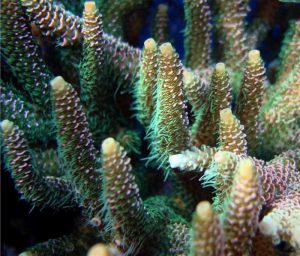
In January 2007 I started running the Polyp-Labs “Reef-Fresh” program which helps keep the nitrate levels in check using bacterial strains, amino acids and other supplements. It is said to give results similar to Zeovit, basically encouraging a low nutrient environment. I have been pleased with the results over this past year or so.
I use Randy Holmes Farley’s 2 part recipe for dosing Calcium & Alkalinity. My reef has a demand which requires almost 500 ML of each on a daily basis to keep the levels stable. Magnesium is added at approximately 500 ML per week as per Randy’s recipe. Potasium is also dosed daily while other trace elements such as Iodine & Strontium are dosed biweekly.
Routine Maintenance:
- Skimmer – empty & clean twice a week


- Pre-Filter bags – change twice a week
- Carbon – change out monthly (media bag runs through an Aquaclear filter in the refugium)
- Water Changes – 10-15% monthly
- Prune & frag corals – as needed
Lighting Schedule:
Main Display:
- 8:00 AM -1 watt moonlights on 10:30 AM – moonlight off


- 9:00 AM – T5’s on 9:30 PM – T5’s off
- 10:00AM – 150 watt 20k m/h on 10:30 PM – 150 20k’s off
- 12:00 PM – 250 watt 10k m/h on 8:30 PM – 250 10k’s off
- 10:45 PM – 1 watt moonlights on 12:00 AM – moonlights off
- white led moon phase light runs automatically via sensor while main lights are out
NOTE: I try to time the photo period in a way in which I can spend more time on the reef while it’s active. By starting the lights a little later in the day they are on for a longer time after I get home from work which gives me more time to tinker and enjoy.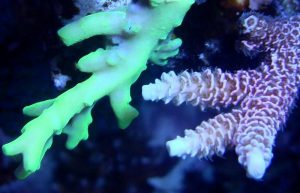
Refugium/Softie Tank
- 40 watt light on reverse photo period in the rear sump “Cheato chamber”
- 8:00 AM -actinics on 11:00 PM – actinics off
- 9:00 AM – pc’s on 10:00 PM – pc’s off
- Frag Tank (250 watt Geisman HQI pendent)
- 9:00 AM – on 9:00 PM – off
Feeding Schedule:
Feeding is provided on a daily basis, generally twice per day, and food is alternated to give their diet a variety of flakes, pellets, brine(super)shrimp, mysis shrimp, cyclopeze and “nori” seaweed. I also mix in some “Reef-roids” or similar product, on occasion to provide some extra food for the corals.
Livestock
Fish & Inverts
Main Display
- 1-scooter blenny
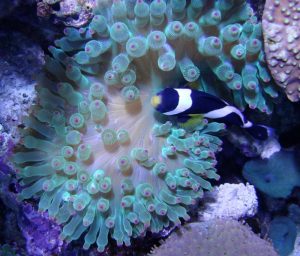
- 1-yellow tang
- 1-blue tang
- 1-naso tang
- 1-chevron tang
- 1-coral beauty angel
- 1-royal gramma
- 1-bi-colour blenny
- 1-yellow tail damsel
- 1-4 stripe damsel
- 3-green chromis
- 2-black & white ocileris clowns
- 1-blue devil damsel


- 2-watchman gobies
- 1-niger trigger
- 1-black brittle star
- 1- Nardoa novaecaledoniae star
- 1 – yellow coris wrasse
- Foxface rabbit fish
- 1-Blood Red hawkfish
- 1-longnose hawkfish


- 1-red serpent star
- Hermit crabs
- 2-conches
- Snails (Too hard to put a number on)
- 1-Entacmaea quadricolor (Green bubble tip anemone)
- 5-hawaiian feather dusters
Refugium/Softie tank
- 1-flame angel


- 2-skunk cleaner shrimp
- 1-yellow clown goby
- 1-marine beta
- 1-purple fire fish
- 1-blue striped pipefish
- 2-orchid dottyback
- 1-pencil urchin
Frag prop tank
- 2-banggai cardinals


- 3-fairy wrasses
- 1-potters angel
- 1-sailfin tang
- 1-rabbitfish
- 1-watchman gobie
- 1-fire shrimp
- 1-sea cucumber
Clams
- 5-Tridacna crocea
- 1-Gigis
- 1-Tridacna maxima
Live Rock
Approximately 400 Lbs containing a mixture from: Australia, Fiji, Jakarta, Vanuatu, Caribbean & Belize, Hawaii, Mexico & Tonga.
Coral
I don’t know all the proper names of many of the corals in my collection so I will only list those that I have identified through research and/or a lot of help from others in the hobby who are more knowledgeable than me. Identification can sometimes be tough when trying to compare an aquarium coral with a picture of one in the wild from a book, especially when you enter reticulate evolution into the equation. With some acropora, I find that I often know what species they aren’t but can’t always tell exactly which species they are, at least while they’re alive. Anyway, I have tried to list the corals by the general taxonomic family first and then by genus and species.

Scleractinian (stony) Corals
Small Polyp Scleractinia
Acropora
A.Loripes, A.Lovelli, A.Rosaria, A.Nana, A.Verweyi, A.Hoeksemai, A.Microphthalma, A.Humilus, A.Gemifera, A.Caroliniana, A.Jacquelineae, A.Prolifera, A.Loisetteae, A.Prostrata, A.Youngei, A.Austera, A.Tortousa, A.Valida, A.Proximalis, A.Millepora, A.Aspera, A.Kimbeensis, A.Batunai, A.Formosa, A.Tenuis, A.Turaki, A.Lokani, A.Horrida, A.Abrotanoides, A.Robusta, AAbrolhosensis, AStriata, A.Pichoni, A.Efflorescens, A.Plana, A.Pulchra, A.Subulata, A.Aculeus, A.Insignis, A.Maryae, A.Cerealis, A.Echinata, A.Bifurcata, A.Convexa, A.Chesterfieldensis, A.Divaricata, A.Hyacinthus, A.Convexa, etc.
Pocilloporidae
Pocillopora Damicornis, Pocillopora Verrucosa, Stylophora Pistillata, Stylophora Subseriata, Seriatopora Hystrix, Seiatopora Caliendrum, Seriatopora Stellata.
Montipora
M.Digitata, M.Capricornis, M.Danae, M.Verrucosa, M.Capitata, M.Confusa, M.Samarensis, M.Flabellata, M.Tuberculosa, M.Aequituberculata, M.Undata, M.Setosa, etc.
Misc SPS.
Hydnophora Pilosa, HydnophoraRigida, Porites sp., Merulina Scabricula, etc.
Large Polyp Scleractinia
Lobophyllia sp, Symphyllia sp, Caulastrea Furcata, Echinopora sp, Favia Speciosa, Trachyphyllia Geoffroyl, Euphyllia Ancora, Euphyllia Divisa, Turbinaria Peltata, Acanthastrea Lordhowensis, Acanthastrea Echinata, Turbinaria Reniformis, Echinophyllia Aspera, Mycedium Elephantotus, Oulophylia sp, Duncanopsammia Axifuga, etc.

Soft Corals
Corallimorpharians (mushroom corals)
Rhodactis, Actinoddiscus (=Discosoma) Striata, Mutabilis, Cardinalis, etc.
Tubipora Musica, Xenia sp. , Alcyonium, Lobophytum Pauciflorum, Sarcophyton Elegans, Sinularia Notanda, Sinularia Dura, Capnella Imbricata, Heliopora Coerulea, etc.
Gorgonians
Briareum Asbestiumi, Rumphella
Zoanthids (Various species)
Pachyclavularia Violacea (green star polyps)
A Few Comments I’ve heard: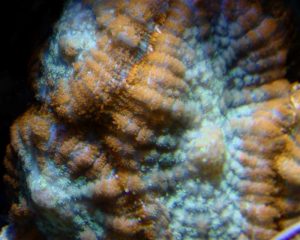
In Michael Paletta’s book “Ultimate Marine Aquariums” he asks his subjects about some of their favorite remarks people make when they see their reefs. I hope he won’t mind me borrowing his idea as I thought it’s a good one and I often get a kick out of people’s reactions when they see my reef for the first time. Here are just a few first time comments:
- Oh my gosh, I’ve never seen anything like this before.
- Is that salt water? Is all that stuff alive? Are those plants? They’re all corals? Even those? Are they real? How did you get them?
- Do you bring these back when you go scuba diving?
- I used to have goldfish but it wasn’t like this.
- I’ve been diving before and it wasn’t nearly as colorful as this.

- One reaction I find quite rewarding is when people simply stand there and say wow. (repeatedly)
- But being of Christian faith, I think my all time favorite comment was when one individual out of the blue stated “I’ve always believed in evolution but after seeing this I think there must be a creator.”
Acknowledgements
I would once again like to thank Advanced Aquarist’s for their interest in featuring my reef and as previously mentioned it’s an honor. I also want to thank all the people who have helped to educate me and given their support since I got started. I would also like to thank the suppliers that have put up with my bending their ear trying to learn from their knowledge. There are so many people I have learned from, too many to mention here but I again want to thank all those who have willingly shared their knowledge, time and friendship. Thanks also to Mike Paletta who was very gracious in giving his blessing when I asked to borrow his idea. I especially want to thank my wife Penny for her years of unquestioning support and always giving me plenty of room to run with my dreams.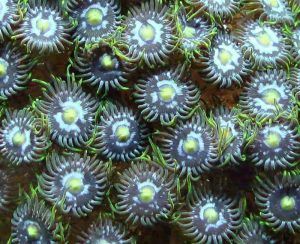
Summary
My aquarium’s look and especially my tastes have continuously evolved. This amazing hobby has taken me up and down and back and forth, through euphoric feelings of reward to great depths of frustration. It is said that experience is what you get when you were doing one thing and expected something else. All the “school of hard knocks” experiences along with my desire to learn and improve have brought me to where I am today and I wouldn’t trade them for anything else. There are of course many things I would do differently if I had a “do-over” but overcoming challenges and hard lessons are often the best teachers. I still have much to learn and am never satisfied for very long with what I’ve achieved so more changes to my reef are imminent. But for now anyway, I have what I would call an “SPS dominated Mixed Reef.” With my reef continually growing and corals so often crowding each other, I have found that regular pruning is necessary so starting a “frag business” became the next logical progression of the hobby for me. Having frags available creates an opportunity for me to meet lots of great people in the hobby, make a lot of cool trades and even get a few costs covered now and then. This hobby has had quite a profound effect on me and has even changed the way I scuba dive. I used to mainly look for the big things; dolphins, rays, turtles, sharks, eels, etc which I will always enjoy seeing, but since having my own reef I spend more of my dives looking at coral details and the small things many people miss such as Christmas tree worms, nudibranchs, flatworms, tunicates, etc. I enjoy it more than ever. I hope that my write up and pictures have provided a little something for everyone to enjoy and that my love for the hobby is apparent through my story. I wish you all good luck and happy reefing.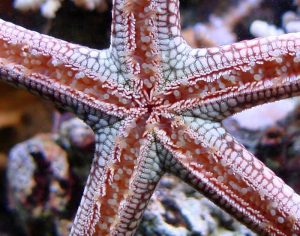


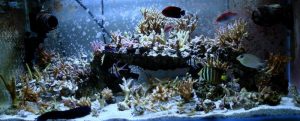
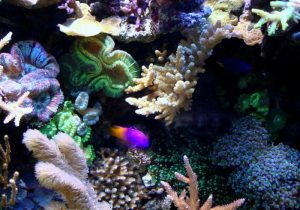


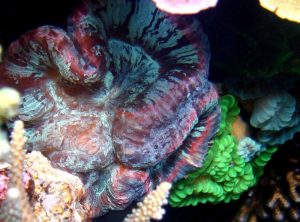
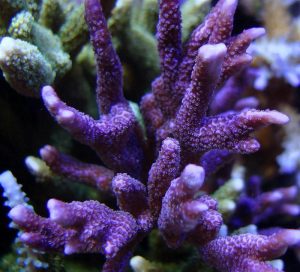

0 Comments